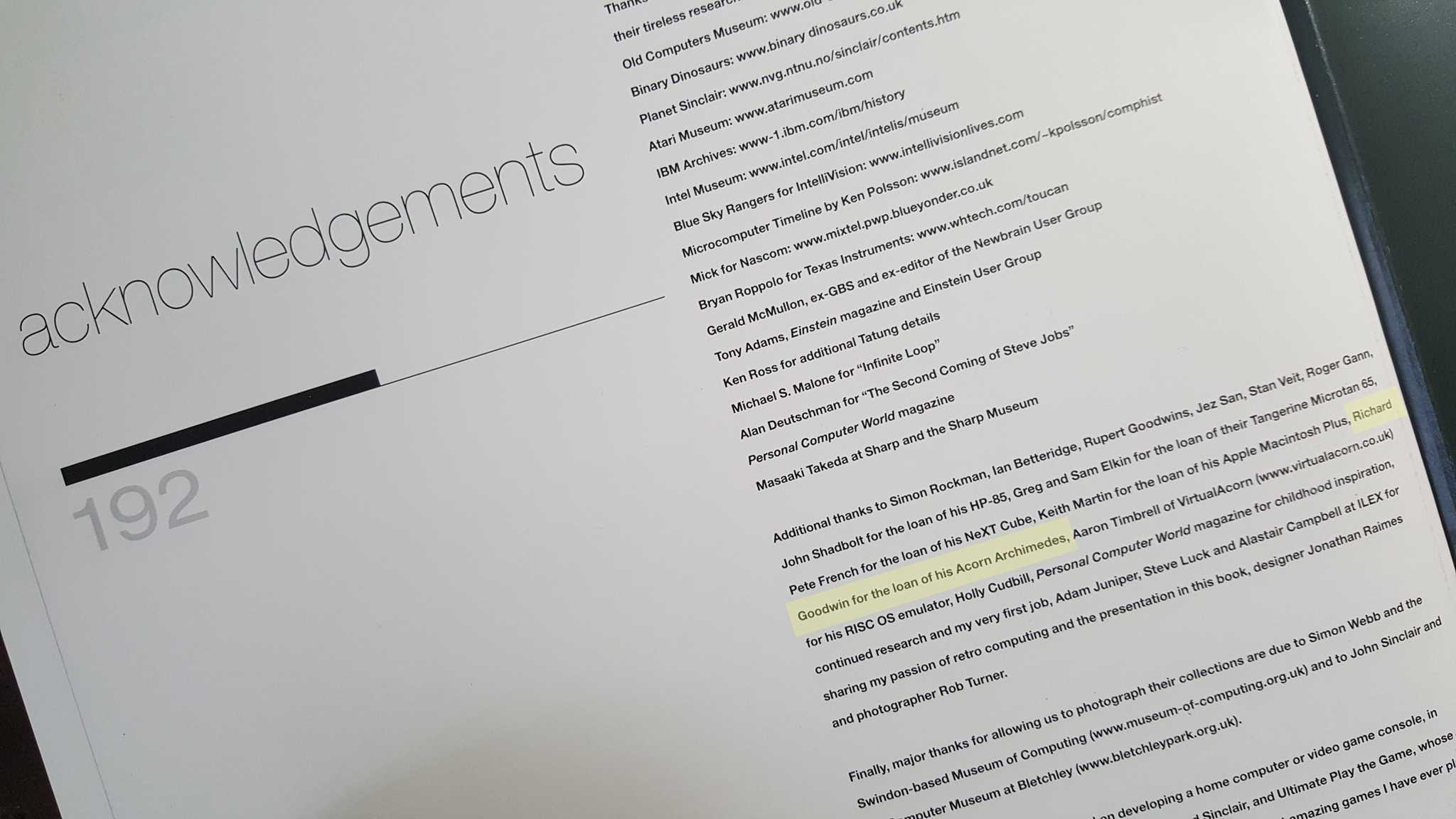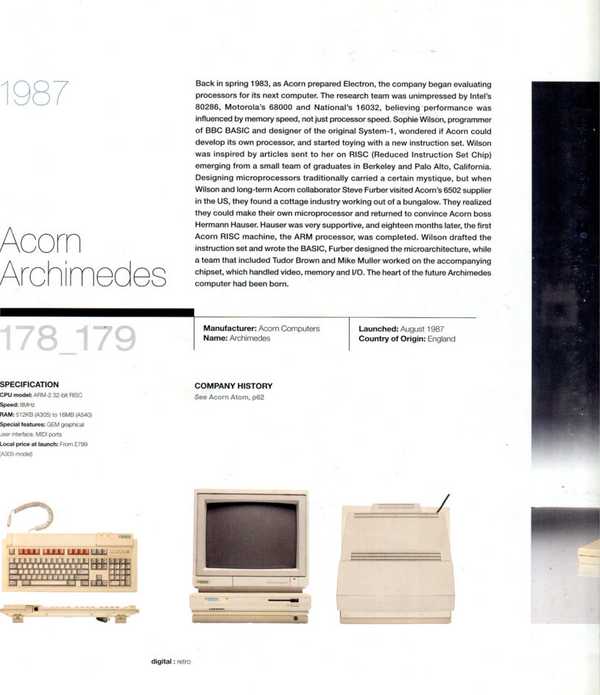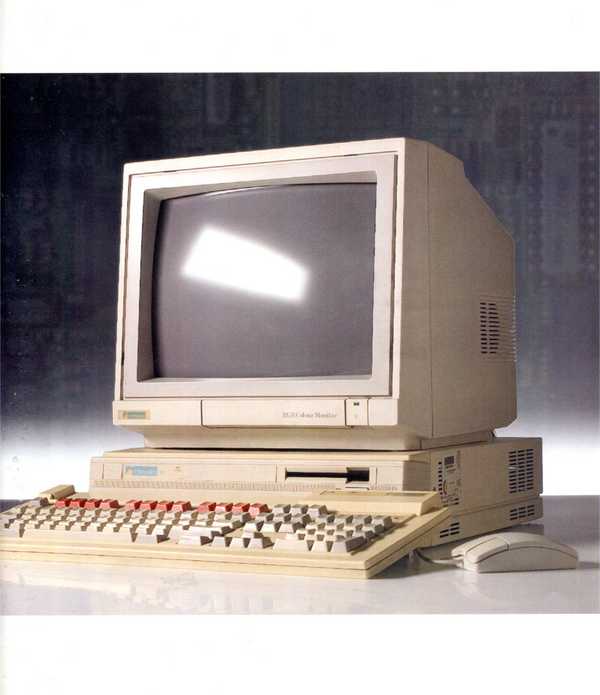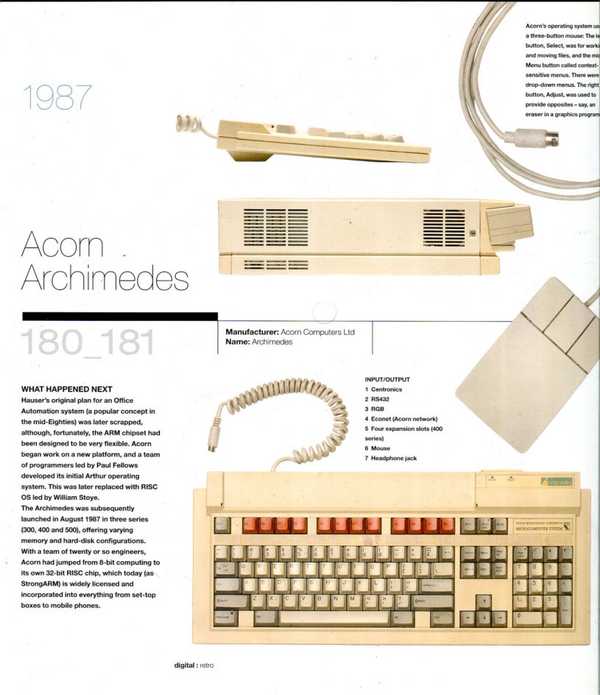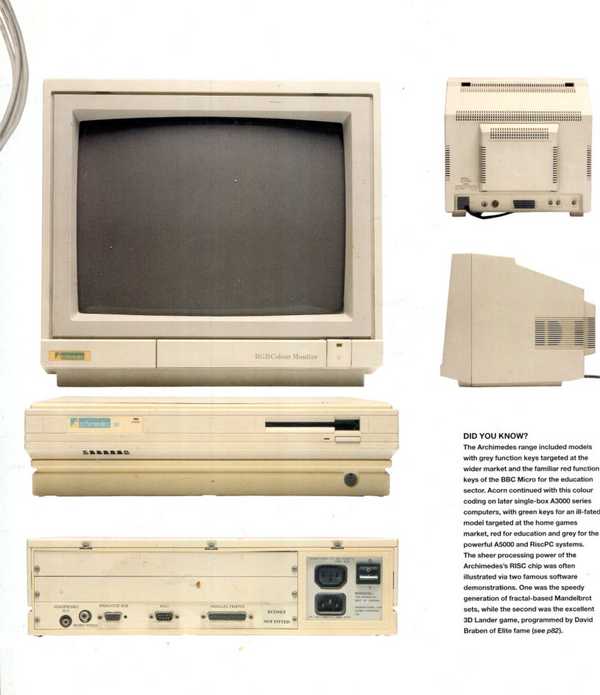A310
Great at the time; and granddaddy to the chip in your phone?

The A310 system, at the time the fastest home computer on the market with an 8MHz ARM2 processor, a whole 1MB of RAM (the A305 0.5MB), and an astounding 256 colours - most PCs of the time were restricted to 4 colours.
The A400 range was essentially the same, but had an ST506 hard disk interface and the memory was upgradable. Some models came with up to 4MB of RAM, which is the limit of these machines (at least, without some hardware hacking).
This much-loved machine has been heavily upgraded since it was bought second hand for the princely sum of £300 a year or so before the RiscPC was launched. It has a four slot backplane (centre) which has allowed four expansion cards to be fitted to the back of this machine.
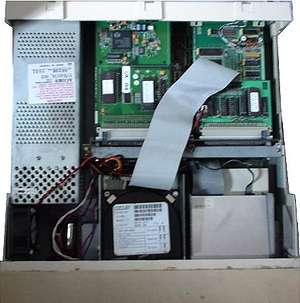
In this image, top right is an IDE interface to allow the hard drive (the black box, bottom left) to be fitted; unusually this is only half the length of the usual card size, and so doesn't go all the way to the back of the case. Underneath is an Ant network card. To the left is a "liberated" NC modem card (not yet working), and underneath this, unseen in this picture, is a Watford Electronics Video Digitiser card.
I remember one TV show featuring a pre-release Archimedes with a Watford video digitiser, which could do 16 greyscale images full screen, in realtime, at enough frames per second to make it look amazingly smooth. My college bought one, and I wrote a "video recorder" for it - I had to write it on my Electron back home (all I had at the time), save it to tape, use a Sony Walkman to get it on to a BBC B, and then serial transfer it to the Archimedes. As I couldn't test the mouse controls on an Electron this was probably the only video recorder that came with an adventure game-style text input parser.
Anyway, this secondhand machine had a digitiser fitted when I bought it, which I later sold for £150 (half what I paid for the whole machine!) long after they went out of production to someone in medical research who was trying to get hold of as many as possible - they were that good. However, I missed it so much I later bought another one for about £30 from someone on the newsgroups.
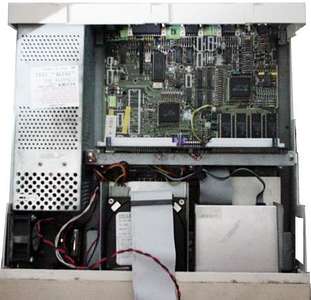
Stripped down further you can see the main motherboard; at the bottom right of this you can see the four RISC OS chips - this machine has been upgraded to RISC OS 3.11. RISC OS wasn't ready by the time these machines hit the market, and so came shipped in the early days with an OS called Arthur.
What you can't see under the floppy and hard drives are the upgraded processor and memory chips (see below). On the A300 range the memory was soldered directly onto the motherboard, and it took a trained technician most of the afternoon to desolder all the chips to fit my 2MB upgrade (which mysteriously upgraded itself to 4MB when I left college, at the same time a sound fault also fixed itself - a miracle!). The memory controller chip had to be upgraded also to the MEMC1a.
Side note - the only way to get more than 4MB of memory is to double-head the MEMC1a chips and have two lots of 4MB for an 8MB machine (4 chips would have 4x4 = 16MB, although I don't know if this was ever attempted).
The ARM2 has been upgraded to a 25MHz ARM3 (again bought second hand for £30 off the newsgroups); part of the upgrade, a board to allow the larger ARM3 to fit into the socket designed for the smaller ARM2, is made of wood!
Starring role
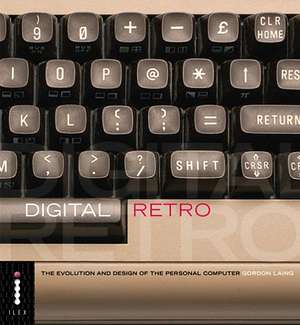
This computer was loaned to Gordon Laing for his book Digital Retro - The Evolution and Design of the Personal Computer.
The plastic on these (and all) Acorn machines tends to age badly, going a darker, more yellow colour. Added to this the only working monitor I had was an ex-school device, which meant a yellow strip had been added all along the case. Not only did the computer come back cleaner (and still working, phew!), but some Photoshop trickery meant it looked better in the book than it did in real life - and the security paint was gone from the monitor.
If you do manage to get a hold of a copy (I think it's out of print now), it's near the back on pages 178-181.
Spares
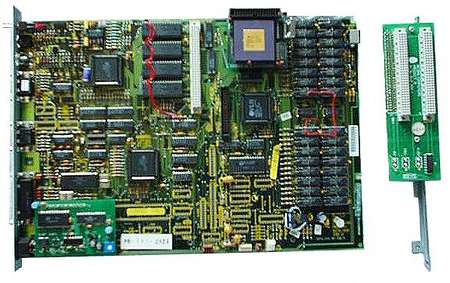
This is a spare motherboard (read: broken bit of junk) from my collection. The big grey chip with the gold square, top right, is a 36Mhz ARM3 - although I believe this was overclocked to death and now only does about 20Mhz, if anything. The big collection of chips on the right is a DIY memory upgrade. Top middle are the four RISC OS 3.1 chips. This machine had a prototype graphics enhancer card fitted (not shown), and a toggle switch for a sound hack can just be seen top left, at the back of the face plate. Finally bottom left is a small card which may or may not be a Midi interface in the Econet socket. To the right of the board is a two slot backplane; the machine originally had a four slot version, but that was salvaged for my working machine (above).
This A310 was donated by Richard Jelbert who used to work for VTi, and designed amongst other things the VTi parallel port sound sampler. It had been modded into a big PC tower case, but when I stripped it down most of the components were covered in mould due to a prolonged stay in a garage.
Uses for the A310
The first hard drive for my A310 came complete with Police fingerprinting powder on it - thieves had gone through the college trashing all the machines with a crow bar to get at the (then highly valuable) RAM inside, but leaving all the hard drives. The machines were insurance write-offs, so the head of Design Technology decided that a couple of hard drives might be of more use to us than the skip. What was I going to do, tell him to put it back?
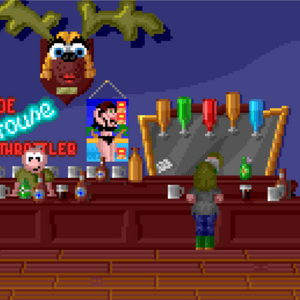
Games
A few old games I was involved in for the Acorn Archimedes range.
This machine was used to design graphics and maps for games such as CyberApe, which didn't sell much; the rather more successful James Pond/Thames Water project, which cost the software house exactly one RiscPC which I carried (monitor, packaging and all) on a train from Southampton back to my home in Nottingham; and some other stuff like the screens for Darkwood that I was responsible for. The idea was that I needed something better than the Electron if I was ever to get that novel finished, which of course I never have.
It was later kept in the living room right next to the sofa and is used mostly as a remote control for my main RiscPC if I can't be bothered to get up and walk to the other side of the room, or if my main RiscPC is at work then I sometimes use it as a remote floppy drive for the other RiscPC that has a fault on the motherboard stopping it using its on-board floppy controller.
